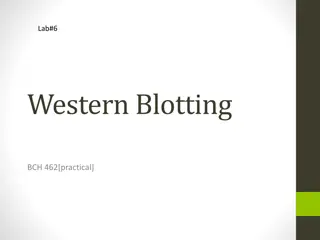
SDS-PAGE Technique for Protein Separation
Learn about Sodium Dodecyl Sulphate-Polyacrylamide Gel Electrophoresis (SDS-PAGE) - a technique used for separating proteins based on molecular weight. Discover the principle, sample preparation process, gel preparation, and more. Explore the applications and visualization of proteins through this widely used method in forensics, genetics, biotechnology, and molecular biology.
Download Presentation

Please find below an Image/Link to download the presentation.
The content on the website is provided AS IS for your information and personal use only. It may not be sold, licensed, or shared on other websites without obtaining consent from the author. If you encounter any issues during the download, it is possible that the publisher has removed the file from their server.
You are allowed to download the files provided on this website for personal or commercial use, subject to the condition that they are used lawfully. All files are the property of their respective owners.
The content on the website is provided AS IS for your information and personal use only. It may not be sold, licensed, or shared on other websites without obtaining consent from the author.
E N D
Presentation Transcript
Overview Introduction Principle of SDS page Sample preparation Process of SDS page Visualization of protein Applications
Introduction SDS PAGE or Sodium Dodecyl Sulphate-Polyacrylamide Gel Electrophoresis is a technique used for the separation of proteins based on their molecular weight. It is a technique widely used in forensics, genetics, biotechnology and molecular biology to separate the protein molecules based on their electrophoretic mobility
Principle of SDS-PAGE The principle of SDS-PAGE states that a charged molecule migrates to the electrode with the opposite sign when placed in an electric field. The separation of the charged molecules depends upon the relative mobility of charged species.The smaller molecules migrate faster due to less resistance during electrophoresis. The structure and the charge of the proteins also influence the rate of migration. Sodium dodecyl sulphate and polyacrylamide eliminate the influence of structure and charge of the proteins, and the proteins are separated based on the length of the polypeptide chain.
Sample preparation of SDS The protein sample is prepared by heating them with SDS detergent and 2-mercaptoethanol until denaturation. SDS strongly binds to the protein and forms a negative charge while 2- mercaptoethanol frees sulfhydryl groups where polypeptide chains with an excess negative charge similar to mass ratio get released. With the protein sample, the buffer solution is added in microcentrifuge tubes and heat at 100 C for 3 minutes. Then the tubes are centrifuged at 15,000 rpm for 1 minute at 4 C
Sample preparation of page For preparing an electrophoretic gel, several components including acrylamide, N, N methylene-bis-acrylamide (BIS), and a buffer solution is mixed together .During polymerization of the gel, ammonium persulfate, a free radical source, and a stabilizer is added and the mixture is degassed or butanol is added to prevent bubble formation. A comb is inserted between the spaces of the glass plate and allowed to polymerize.
Process of SDS PAGE Boil the sample for 10 minutes to completely denatures the proteins. Assemble the gel into the apparatus. Pour the buffer solution into the chamber. Load 20ul the samples into the well. After that run electrophoresis by connecting the current supplies.
Visualization The use of colored dyes is non-specific i.e, it targets all protein and these stains are non-reversible as well. This non-specific protein visualization is used for quick quantification of samples in a gel. Specific protein visualization requires the use of antibodies conjugated with a dye or enzyme that recognizes the unique structure stern blotting is also associated with protein visualization by moving proteins from a gel to a membrane that can be probed with antibodies. The molecular mass of the unknown protein sample is determined by comparing the distance traveled by the unknown molecules with the marker.
Application It is used to measure the molecular weight of the molecules. It is used to estimate the size of the protein. Used in peptide mapping. It is used to compare the polypeptide composition of different structures. It is used to estimate the purity of the proteins. It is used in Western Blotting and protein ubiquitination. It is used in HIV test to separate the HIV proteins.






















